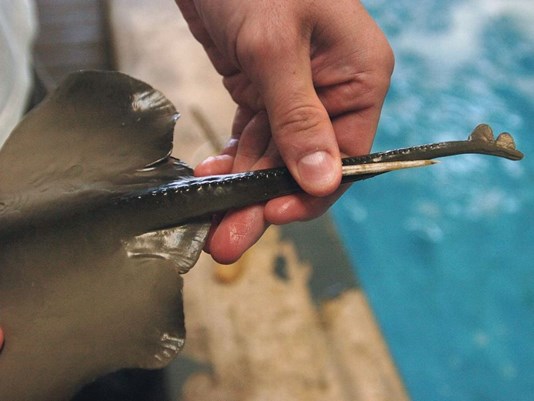
As WTSP reports:
It’s stingray season and just this week alone, about a dozen swimmers have been stung along North Clearwater Beach.
The warm waters of the Gulf attract more stingrays over the summer months, through October. They spend most of their time hanging out in shallow water just off shore, partially buried under the sand. They’re hard to spot since stingrays are almost the same color as the sand. That camouflages them from predators and humans.
Stingrays don’t attack out of aggression, and they don’t bite. What you do need to worry about is the stringray’s barb. It’s at the end of the spine, right on top of the tail. The barb has a sharp point and sometimes serrated edges, like a knife. Some stingrays have venom on their barbs. If you get stung, you might not see it, but you’ll feel it!
You don’t have to let the warnings about stingrays ruin your fun day at the beach, all you have to do is what’s called the ‘stingray shuffle.’
Brooke Bowersox is an Animal Care Specialist at Clearwater Marine Aquarium. “Those vibrations that your causing in the sand is going to alert the animals that you’re in the area and they’re most likely just going to swim away.”
Alycia Proskos was not doing the shuffle. “I just felt this stinging pain on my foot and I just basically ran out and then saw my foot bleeding.” She says she was in ankle deep water when the stingray’s barb struck her between her toes. “It just felt like a bee sting, but just amplified like way more intense than a bee sting, but [the] same kind of feeling.”
According to Bowersox, “The Southern stingrays are going to be the most common that you’re going to come across. They tend to inhabit shallow waters and they’re a bottom dwelling species, meaning that they’re typically going to hang out on the bottom and bury themselves in the sand a little bit.”
Just this week, nearly a dozen people have been stung prompting lifeguards to put up the purple flag to warn swimmers. “We have to rely on when people start getting stung, that’s when we realize that we do have a lot more than usual sting rays and that’s when we’ll raise the purple flag.” said Jason Beisel with the city of Clearwater.
If you’re headed to any area beach, it’s recommended you swim near a lifeguard stand. And if you do get stung, let a lifeguard know right away so they can help.
“Also, the more beachgoers that there are, the more potential there is for those stings to happen.” said Bowersox.
So far all the reported stings have been in the North part of Clearwater Beach, but it can happen anywhere and it is stingray mating season so you’re still going to want to do the stingray shuffle at any beach.

